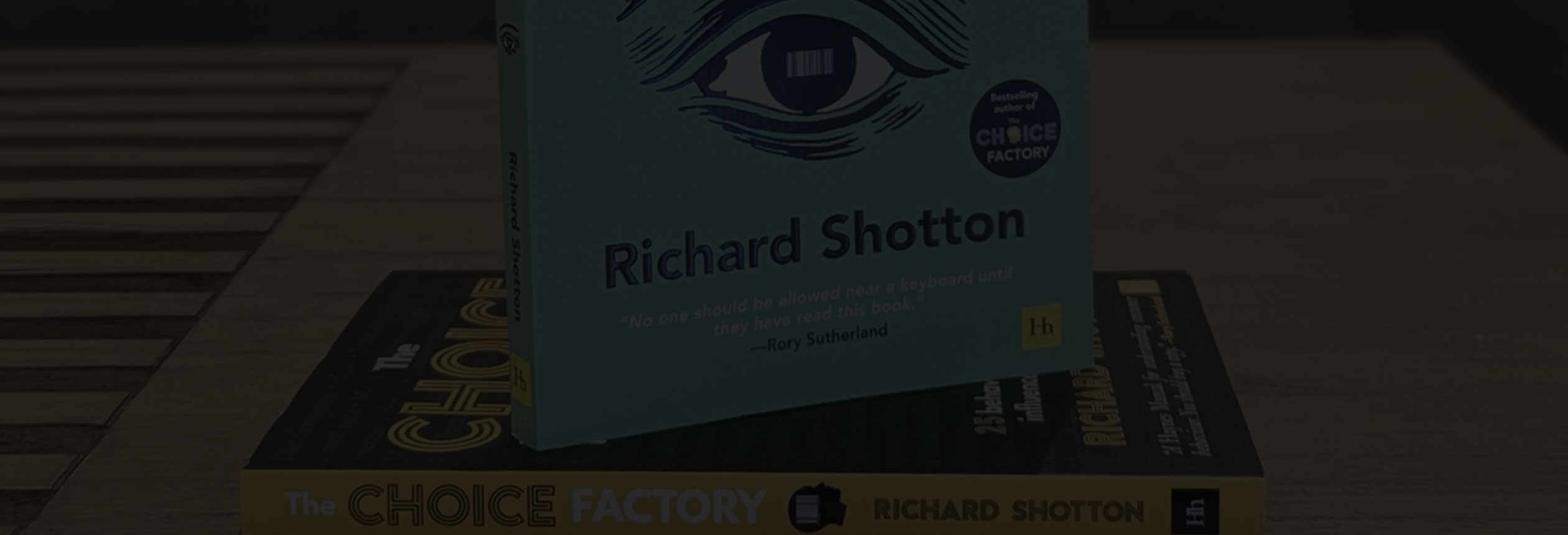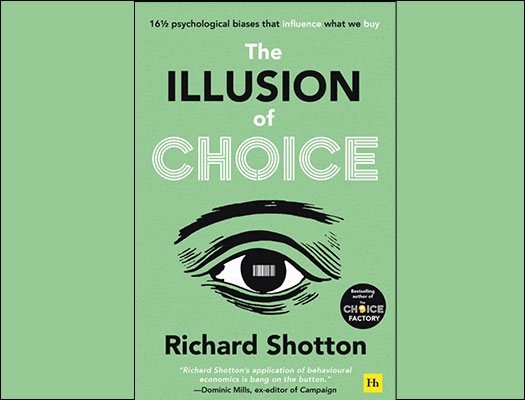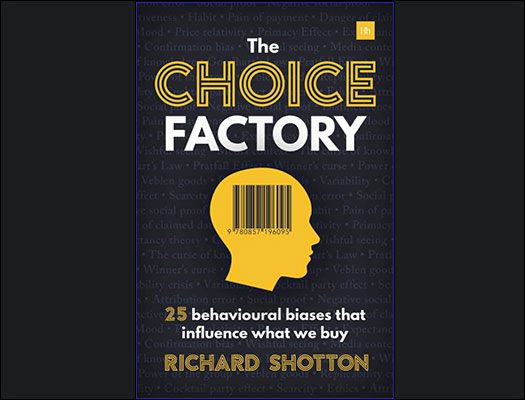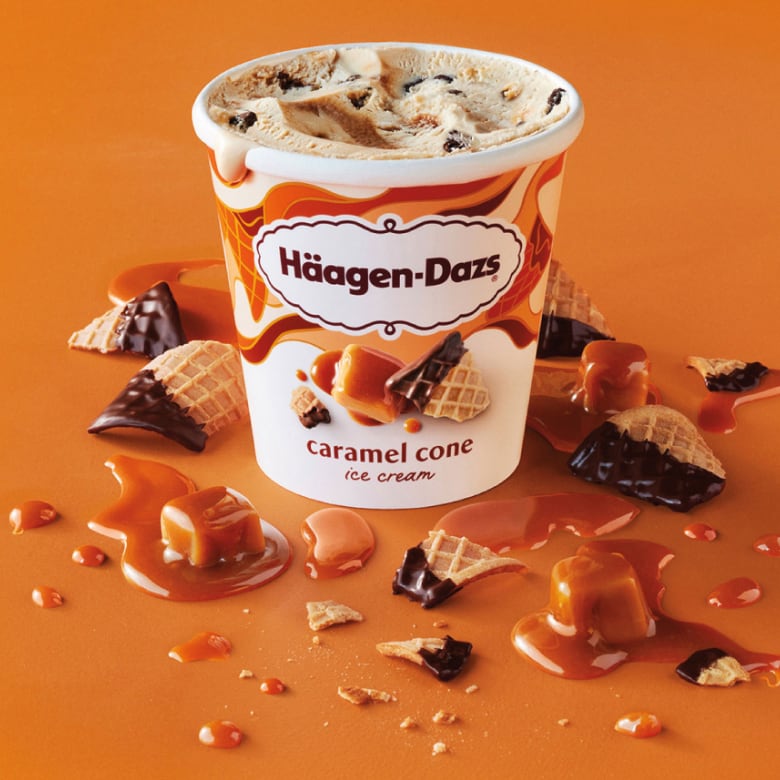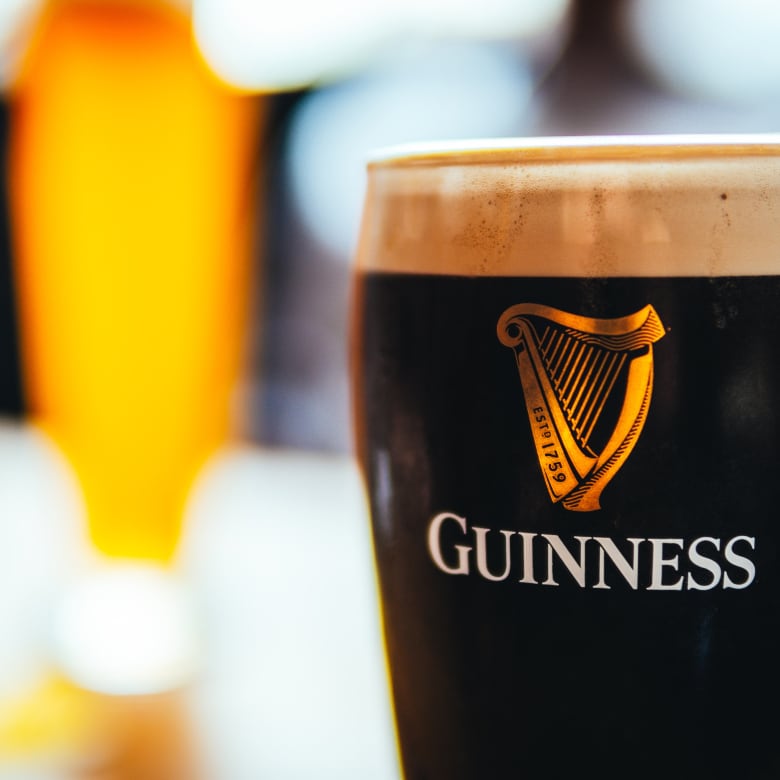00:00 / 24:59
Episode Transcript
- MichaelAaron: Welcome back to Behavioral Science for Brands, Richard and MichaelAaron’s podcast, where we get nerdy on all things behavioral science. Today we have an extra special episode rather than our normally scheduled programming of diving deep on behavioral science in the world, we're going to take a look at Richard's shiny new book, The Illusion of Choice.
- MichaelAaron: Stay tuned for exclusive content from our author himself. Hear about the stories that inspired the book, and most importantly, hear how Richard thinks we can all use this new book to make marketing in the world stronger. I'm MichaelAaronAaron Flicker.
- Richard: And I'm Richard Shotten.
- MichaelAaron: So Richard, congratulations. A second book is no small feat, and we'll talk a little bit about The Choice Factory, your first book, but this second book is coming out with much praise. Rory Sutherland, author of Alchemy and vice chairman at Ogilvy says, quote, No one should be allowed near a layout pad or a keyboard until they have read this book. It is the antidote to the tedious, direct and transactional nature of much of modern marketing, what praise and Les Benet says. “It's useful and fun, a great bag of little tricks.” Very British sense of compliment. And Robert Cialdini. Author of Influence and Persuasion says it's a trove of useful insights that are both grounded in scientific research and presented compellingly. How do those reviews from the industry make you feel?
- Richard: Yeah, well, very positive. Robert Cialdini was one of the first people who I started reading about when I first became interested in behavioral science. So now his influence has been phenomenally important to me in, in shaping how I approach discipline. So yeah, very nice to hear those, those words.
- MichaelAaron: To me, it really speaks to a community forming around behavioral science of those who really want to support more research, more writing, and more people getting engaged, which is just, it's a really great moment in the world of behavioral science, right now.
- Richard: Yeah, I think that's true. I've heard Rory Sutherlands speak where he said, well, he'd rather be a little fish in a big pond than a big fish in a, a small pond. He just wants to, to grow behavioral science as a field. So, you know, it's his interest to support everyone in, in that area. And I, I think he's quite passionate about spreading the word because there's a belief. That it'll make marketing stronger if you harness these ideas.
- MichaelAaron: And I never heard that quote, but it aligns so nicely with why we created the Consumer Behavioral Lab in the first place, wanting to spread the work of behavioral science throughout, uh, north America when it's been so popular in the United Kingdom in Europe before really helping reach. American audiences of marketers and advertisers and really helping them think about how to get behavioral science snapped into their businesses today.
- Richard: There's a body of work out there that's so useful for marketers that isn't getting applied enough. Absolutely.
- MichaelAaron: So Richard, before we jump in and talk about the book, why don't you tell us a little bit about your backstory, what led Richard Shotton to want to get involved in behavioral science in the first place.
- Richard: Unlike most things in life that you just gradually drift into, there was a very specific moment when I first became interested in behavioral science. Back in 2004. I was working on a brief for the government health department. We were trying to encourage people to donate blood.
- Richard: So I was an agency at the time, and I happened to read about an idea called the bystander effect. So that's an old sixties experiment from two American psychologists, Latane and Darley and essentially their work shows - If you ask lots and lots of people to help you, lots of people to come to your aid, each individual is slightly less likely to do so cause there's a diffusion of responsibility.
- Richard: So having read that, At the time we were responding on this brief, I went and spoke to the creative agency and said, well, look, why don't we tweak our creative? And rather than say, bloodstock are low in England, please come and donate. Why don't we try and create a personal sense of responsibility and start saying, blood stocks are low in Birmingham War London, please donate.
- Richard: And that tiny crude tweak to the creative had an immediate 10 to 15% impact on the cost per acquisition. So I was intrigued that we could take these ideas from the academic field of psychology, and then as that example showed, you could apply them to your media or creative and see an immediate response. So I was hooked after that and became immersed in the subject, started grow my own experiments, moved on to specializing it.
- MichaelAaron: That story, that behavioral science can be very big and very academic, and you can enjoy nerding out as you and I do when we get together for these podcasts, but you can also find things very concretely that can be applied and make a real business effect. Can you talk a little bit about your opinion of how you can test and learn with behavioral science?
- Richard: That's a great question because sometimes you'll come across studies where they're interesting, but maybe the academic random in such a different situation. You don't think they're applicable. What you can do is take the methodology of that academic study there. It's all in the public domain, and you can rerun it with a few tweaks to make sure it's relevant for your challenge.
- Richard: So if that all sounds a bit wooly and abstract specific example, there is a well known set of ideas called the pennies a day effect. So longstanding idea shown amongst charities that if you ask for a pound a day or a dollar a day, you are more likely to get a donation than asking for $30 a month. You and I read about that and we thought, well that's interesting.
- Richard: Could that principle that recutting the price be applied more broadly to commercial brands? So a study we ran last year into an idea we're calling unit reframing. We told people about 12 bottles of Sierra Nevada Pale Ale. They cost $18 99. And we asked people how good value they thought they were and 13% of people thought they were good or great.
- Richard: Then got another group of people exactly the same brand volume of bottles and price, but we added on half dozen words. That's the same as $1 58 a bottle. And when we did that in that second group, we saw a more than doubling of people who thought it was good or great value. It goes up to 28%. So that to me is how you should approach these studies.
- Richard: Sometimes they won't be perfect, so you can take them, rerun them, and then you can show that they work for your particular brand. And if you think about the study we did, the key thing with the methodology is you don't ask people directly. You don't say to them, here are two prices, which would you?
- Richard: Because people will say they're exactly the same. You split people into cells or different groups. You show one person version a second, group version B, everything the same, apart from one change variable, and then any difference in response, your tribute back to that single change variable. That approach is remarkably flexible and remarkably useful to getting to the truth.
- MichaelAaron: Take the learnings we share in the C B L that you read in a book and then find a way to apply it to your own brand, to your own campaign, and as you say, change only one element to see if that changed element leads to a business effect.
- Richard: Exactly. And people shouldn't fear doing that. If you have a website, if you have a series of stores, you essentially have laboratories now AB test your website visitors half C, version A, half C, version B. You can quickly learn whether applying these biases to your copy, your sales site have an effect.
- MichaelAaron: That was one of the most impactful things when I first read The Choice Factory, your first book. I got those examples that I could start to play with on brands I was working on or on projects that I had. Can you tell us, remind for those that are listening to the podcast today that may have not read the book, what do you cover in the first book? The Choice Factory.
- Richard: So in the Choice Factory, I look at 25 behavioral biases that I think are relevant to marketers And so each chapter, I'll take one bias or psychological insight. So it might be social proof, it might be a pratfall effect. And then in each chapter I run through the academic evidence for that insight. Then I talk about the experiments I've run to those insights are still relevant today and they're relevant commercially. And then the final, the bulk of each chapter, the most important bit is now you know about these psychological insights. What should you do differently? And I really wanted the book to be simple and practical that everyone could put to use.
- MichaelAaron: And really very well received in the market. Very well used. When we go around and speak to people, they have it on their bookshelf. They know about it. What led you to then want to write a second book?
- Richard: Well, five years Choice Factory came out in 2018. Over those five years I was running more experiments. And also over those five years, I got to know about less well insights from psychology are that I think are just are relevant. So The Illusion of Choice is a standalone book, but it follows a similar theme in it I identify what I think are the 16 and a half most interesting psychological insights that marketers can apply that weren't in the Choice Factory. And again, for each of them, I just go through, here's the evidence, here's my research that show they're relevant today. And then most importantly, the practical application.
- MichaelAaron: Nobody can miss that it's 16 and a half psychological insights. Tell us a little bit about why you chose 16 and a half.
- Richard: So partly, I had always had a book I really liked by an English author called Julian Barnes. And it's the history of the world in 10 and a half chapters. And it had always caught my eye and stuck in my mind.
- Richard: And you know, I just liked that as a bit of style. But then I read about a study by Schindler at Rutgers University where he recruits a group of people, shows them an ad for a deodorant. And half of the people who see the ad hear that it reduces perspiration by 50% half hear that it reduces perspiration by 47 or 53%.
- Richard: When he then questions all those people as to how much they believe the ad, how accurate they think that claim is, he sees a mark's difference. So people who hear the rounds claim the general claim score lower in terms of belief and the credibility and the accuracy of the ad compared to people who saw the precise claim.
- Richard: And we're talking about the order of five or 10. So what Schindler argues is over time people learn that communicators who speak generally don't really know what they're talking about. Those who speak in specifics are much more sure of themselves, and then they apply that to how they interpret messages from brands or from authors.
- Richard: So there's a whole chapter on precision in the book. That is the half chapter. So I thought, why not apply some of these ideas to the book itself? It'll be far more memorable if it's 16 and half than if it's 17 or 18 or 25.
- MichaelAaron: It's one of those great moments where you read it, it's immediately intriguing whether or not you understand the backstory to the behavioral science. And isn't that the beauty of behavioral science? Yeah. You don't have to know the theory that powers.
- Richard: Oh, absolutely. So in Shinder study, those people who took part didn't know the power of precision. They're randomized into two groups, yet they thought the deodorant was 10% more accurate in its claim, 5% more credible. Its claim. Yes, absolutely. The audience doesn't need to know necessarily, uh, the bias that's being applied for that bias to have an effect.
- MichaelAaron: Even though The Illusion of Choice follows the same structure as the Choice Factory, you're covering new psychological insights into the book, but you also have some new research that's powering the book.
- Richard: Yeah, that's right. Thanks for clarifying that. Absolutely. The experiments covered don't overlap in any meaningful way with The Choice Factory. You know, the 80 experience we talk about, maybe one or two do, and I, I mention those directly. So yeah, it's additional insight. And yes, there is additional research that I've done.
- Richard: So for example, there's a chapter on concreteness. There's this long-standing idea that people are much, much more likely to remember language that is concrete that can be visualized rather than language that is abstract. The initial work for that was done by a brilliant Canadian psychologist called Ian Beg back in 1972 when he was at the University of West Ontario.
- Richard: But the study he ran was 25 students and a frankly bizarre set of words that he asked them to recall at a later date. Now, the problem with evidence based on students is they aren't necessarily a representative group, and the study's 50 years old, and he did it on a very, very small sample size. So he had an interesting finding.
- Richard: But frankly, I wouldn't be that comfortable trying to persuade a multinational brand to change their million pounds creative based on that bit of evidence. So working with marketers, we reran back study. We got I think 400, maybe 460 people nationally. Representative. We read out ten two-word phrase. So things like happy hens or high quality or fast car or trusted provenance, and we then got people to read them, and then a few minutes later, five minutes later, we asked them to recall as much as they possibly could.
- Richard: And what we found was that people were 10 times more likely to remember the concrete visualized words. So things like happy hand or fast car, rather than the abstract phrase like trusted providence. Begs finding still stands today and if anything, if you make it a little bit more accurate and reflective of the situation, marketers find themselves in.
- Richard: I not asking people immediately after having read the list of words, but putting a little gap of time. If anything, the effect is even stronger. So Begs argument that vision is the most powerful of our senses. And therefore, words you can visualize are more sticky. That seems to hold. And I would argue that is a very, very relevant finding for marketers because too many marketers speak in abstractions.
- Richard: You know, they talk about things like being trustworthy or high quality, or, uh, local providence, they use phrases that people can't picture. Now it's fine to have those abstract items as objectives, but if you are going to communicate them to an audience, you need to translate them into more concrete visualized proxies. And if people can do that, they're tapping into one of the strongest, most powerful memory biases that's around.
- MichaelAaron: Amazing. Cool. Let's move on to the next topic. So as you're going to write the book Richard, What was the most surprising for you? Maybe something surprising that you learned or the experience that was surprising. What was unique about the process of writing this book?
- Richard: I think the most surprising bias that I read about and learned along the way was around fairness. So I came across a study by Sally Blo and Max Basin, I think when they were at Northwestern. And in it they go out and as students are arriving at the university they give them an offer. They say, will you come to our lab tomorrow and do 40 minutes of puzzles and we'll pay you $7? And when they make that offer, 72% of people agree. This was 1996. So $7 was a lot of money. So that's their first group. Second group of people they go up to and they again say we do 40 minutes of work in our lab tomorrow, but they change the price, they'll change the wage that they're offering.
- Richard: They increase it by a dollar. So now they're offering $8. But they say to those people, little white lie, they say, I'm really sorry, but we were paying people $10 this morning. Um, but we've now run out of cash and we can only give you 8. Now in that scenario, that second group, the one who were getting paid more, there is a reduction in willingness to pay part.
- Richard: You now get 54% of people agree. So first it seems to completely contradict basic economics. A group of people who are being offered more cash are more likely to refuse the job offer. But what Blo and Basin argued is when people are weighing up an opportunity, they are not just influenced in the financial gain, they're also interested in.
- Richard: Treated fairly. So in that second scenario, people are aggravated by the sense that others could be doing better, and therefore they're prepared to turn away from what could be a very profitable opportunity. Now that idea, I think you can take and apply it as a brand today. On a macro scale, you can try and reframe your competitors as behaving unfairly, you know, taking the mickey out of their customers.
- Richard: If you do that, you'll be using a very powerful bias to encourage people to leave your competition or on a really, really tactical level. When you are designing your e-commerce site own, put a giant box by the checkout, which says add your discount code. because that transgresses fairness numbers. What happens is people who are completely happy to say pay a hundred dollars repair of trainers, they get to the checkout, they see that discount code box, they realize other people are getting a better deal and therefore they thrive their hands and think this is unfair, and they go and shop elsewhere.
- Richard: So you can apply this principle on a macro level or a micro level, but what surprised me was quite how a large impact this find.
- MichaelAaron: It makes me think about how people evaluate and offer and without some other bit of information, giving it a relationship without something telling you how to evaluate the dollar amount absent of that. The human condition is to just go and say, is it worth it or not? But as soon as you introduce something else, either when we do pricing strategies and you have good, better, best, or small, medium, large, they now have something to compare the price to. Or in this example, if they have some other piece of information like you were getting paid more than somebody else or less than somebody else, that gives them more information to make their decision with. Yeah, which isn't always good.
- Richard: You are absolutely right. People do not approach prices or wages just as cold calculating machines. There are many ways in which you, as a behavioral scientist or a brand, can change people's reaction to that number without giving them more value. So firstly, you're right. If you are ever entering a negotiation, giving someone a, a wage rise, uh, or increasing your prices as a brand, don't just give people the number.
- Richard: Give them an explanation of why you are passing on, say, in terms of the price rise, passing on additional costs as a brand yourself. That will make people treat the increase very differently from if you just arbitrarily impose it because there is a very different reaction to brands that are trying to increase their profit margin of brands that are just passed on costs. There are a number of studies by failure that show that.
- MichaelAaron: Yeah, and so your point here is that if you even try to explain the cost of the price increase, just explain that it's not just for brand profit, it's for helping. It's because by market conditions or whatever the situation is, even just that little bit of explanation introduces new information that can make them more receipt.
- Richard: Absolutely. If you're laboring under a mental model that consumers are rational value maximizers, you might be sitting there and thinking, well, I'm just going to tell them the price rise, and they'll have to weigh up the value we give them as a brand versus the cost. But that is a mistake. People will bring in these other factors.
- Richard: So you need to be aware of those factors so that you can, you know, maximize the probability that the customer will accept. It's the argument against classical economics and for behavioral economics. Yeah, I, no, no. I would say there are many situations in which findings and classical economics will work.
- Richard: However, there are significant opportunities and potential advantage you can. Bring to your business by applying behavioral science as well as economics.
- MichaelAaron: So like every time we get together, Richard, we've talked lots about studies and about the science that powers our approach to behavioral science, but let's touch on a few of the human sides.
- MichaelAaron: What's it like to write a book? I think people are interested to hear what is it like to set out on this big project to gather information and record it down? How did you approach it? What does it feel like to write your second?
- Richard: I think the single best thing I did to make it reasonably easily was chunk up the problem. So if I had written a book with a single thread of an argument, one standalone idea, 40,000 words, I think it would've been very, very tough. Split it into 16 and a half or 25 different chapters and straight away, it makes it much easier. It's very easy to sit down in the morning and consider writing a 2000 word chapter.
- Richard: It's much, much harder to sit down and think you're writing at the beginning of a 45,000 word book. So if people are considering writing a book and you want to make it easy for that approach, uh, that I took, I think could be applied in a broader set of settings.
- MichaelAaron: Feels like you're taking our beloved behavioral science and applying it even to the way you wrote the book itself.
- Richard: Yeah. The other one that I think I've applied, there's amazing study by, uh, Princeton psychologist Daniel Oppenheimer. It's this wonderful paper called ‘Consequences of Erudite Vernacular Utilized Irrespective of Necessity: Problems with Using Long Words Needlessly And then there's a
- MichaelAaron: I have no idea what that means.
- Richard: Yeah, exactly. That's the point.
- Richard: Yes. So then there's a colon that's just half the title. Then it says, the danger of using long words needlessly. So it's a little bit of a joke in the title. And what he shows is if you give people essentially the same bit of writing, but one's in a jargon, heavy style complex, and one's written more simply.
- Richard: He shows if you give those bits of writing to different groups of people, the group that see the simpler style will rate the author as being more intelligent by about 13%. So when I read that, I had in my mind all the way through the book, which is there is a tendency to think as a writer that you need to use complicated words or drop in lots of aerodyne jargon, but.
- Richard: Oppenheimer says that will backfire. So what I've really, really tried to do with the book is keep it very simple and behavioral sciences heart is a simple topic that has powerful implications that unfortunately too many academics dress up in ridiculous fibrous language. So that's the other study I try to apply, write it as I would speak, right in a simple way.
- MichaelAaron: Brilliant. And it make the work so accessible. So as we come to a close, maybe you can share with all of our listeners how you hope people will use the. What do you hope people take away? How do you think they can use the book moving forward?
- Richard: So my main hope that people apply it. So rather than just read it and think, these are interesting quirks about human nature as you're reading it, think how can I apply this on my brand for my client today or tomorrow?
- Richard: So what are the simple, easy to adjust ways in which this can be applied? And I would definitely, if working with a client for the first time and they're not familiar with behavioral science. Pick the ideas that can be applied very, very quickly and easily, and with limited cost. Run a few of those studies, run a few of those experiments, show the impact, and then move on to the more profound ideas or more strategic ideas.
- MichaelAaron: Always a pleasure to speak with you, Richard, and always a pleasure to get together for another podcast. So that brings us to the end of our episode. If you like what you heard today, we appreciate a thumbs up, a good rating, a review, and be sure to come back next time. We are getting ready for the next season of Behavioral Science for Brand Podcast, uh, where we are going to continue to dive deep into interesting and exciting behavioral science topics. Until then, I'm MichaelAaron Flicker.
- Richard: And I'm Richard.
- MichaelAaron: For all our listeners and fans of the Consumer Behavior Lab, Richard and I were thinking of ways to continue to power our future seasons. We'd love to invite you to use our web form to submit questions you have on behavioral science, things you'd like us to cover in future episodes. And to sweeten the deal, Richard has offered to sign five copies of his book and we will send five copies to the best questions or ideas that we get. So please visit the consumerbehaviorlab.com and scroll down to the bottom of the page, submit your ideas on the web form and give us your address and we'll choose five of the best to get a special signed copy from
- MichaelAaron: Richard himself. Seems like a pretty high value.
- Richard: Oh yeah. Definitely. Worth 30 seconds of effort at least. Yeah. ,
- MichaelAaron: MichaelAaron: if not more. Yeah, 45. 45. Yeah, exactly. Behavioral Science for Brands is brought to you today by Method1, a digital first marketing company that brings science to the art of persuasion. They're behavior change experts who solve business challenges by creating meaningful connections with consumers.
- MichaelAaron: Method1 has a deep discipline across many brand categories. To unlock behavior change that fuels brand growth, visit [email protected]. That's method and the number 1.com.
Episode Highlights
16 1⁄2 Psychological Biases
Robert Schindler examined whether consumers make the false assumption that claims using sharp numbers are more likely to be factual than those using round numbers. "Why not apply some of these ideas to the book itself? It'll be far more memorable if it's 16 and half than if it's 17 or 18."
Clear, Concise, & Conversational
A main take away when writing the book came from psychologist Daniel Oppenheimer - keep your messaging clear, concise and conversational. Write it as you would speak, write in a simple way. If you need to get complex or technical - break it down into manageable chunks.
A Tool for Application
"Rather than just think these are interesting quirks about human nature as you're reading the book, think how can I apply this on my brand for my client today or tomorrow?"
